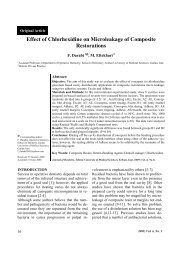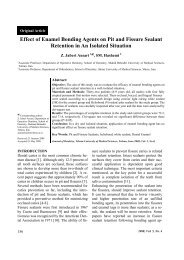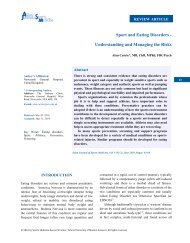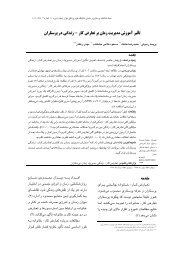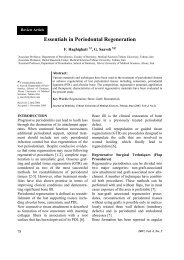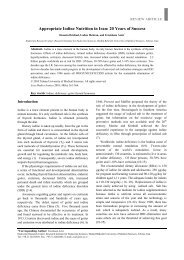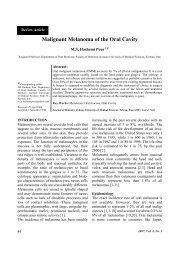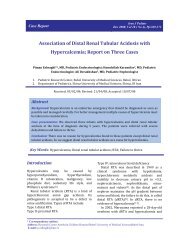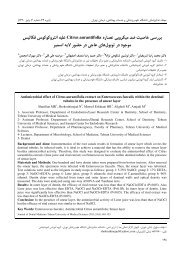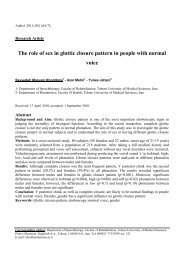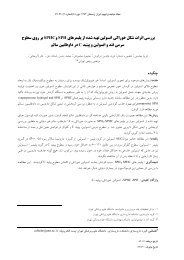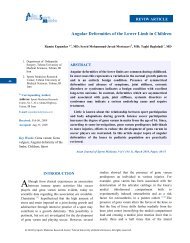Significance of Postnatal Follow-up of Infants with Vesicoureteral ...
Significance of Postnatal Follow-up of Infants with Vesicoureteral ...
Significance of Postnatal Follow-up of Infants with Vesicoureteral ...
You also want an ePaper? Increase the reach of your titles
YUMPU automatically turns print PDFs into web optimized ePapers that Google loves.
Original Article<br />
<strong>Significance</strong> <strong>of</strong> <strong>Postnatal</strong> <strong>Follow</strong>-<strong>up</strong> <strong>of</strong> <strong>Infants</strong> <strong>with</strong> <strong>Vesicoureteral</strong><br />
Reflux Having Antenatal Hydronephrosis<br />
Murat Kangin *1 , MD; Nejat Aksu *2 , MD; Onder Yavascan 2 , MD; Murat Anil 3 , MD;<br />
Orhan Deniz Kara 4 , MD; Alkan Bal 2 , MD, and Fulya Kamit 2 , MD<br />
1. Diyarbakir National Hospital, Diyarbakir, Turkey<br />
2. Department <strong>of</strong> Pediatric Nephrology, Izmir Tepecik Training and Research Hospital, Izmir, Turkey<br />
3. Department <strong>of</strong> Pediatrics, Izmir Tepecik Training and Research Hospital, Izmir, Turkey<br />
4. Ege University, Faculty <strong>of</strong> Medicine, Department <strong>of</strong> Pediatric Nephrology, Izmir, Turkey<br />
Abstract<br />
Received: Dec 28, 2009; Final Revision: Jun 04, 2010; Accepted: Aug 09, 2010<br />
Objective: To evaluate the frequency <strong>of</strong> urinary tract infections (UTIs) and degree <strong>of</strong> renal<br />
parenchymal damage as well as the parameters <strong>of</strong> growth, development and nutritional status<br />
in antenatal hydronephrosis cases <strong>with</strong> vesicoureteral reflux (VUR).<br />
Methods: <strong>Infants</strong>, whose antenatal ultrasonography (US) showed a fetal renal pelvic diameter<br />
<strong>of</strong> 5 mm or greater were investigated. Of the 277 infants <strong>with</strong> antenatal HN, 36 [56 renal units<br />
(RUs)] were diagnosed <strong>with</strong> VUR. All cases <strong>with</strong> VUR were evaluated in terms <strong>of</strong> the frequency<br />
<strong>of</strong> UTIs, scars appearing on 99m Technetium-dimercaptosuccinic acid scan (DMSA), growth and<br />
development [height and weight standard deviation scores (HSDS and WSDS)], and nutritional<br />
status [relative weight (RW)]. Statistical evaluation was performed using the Chi-squared test.<br />
Findings: Of these 36 patients <strong>with</strong> VUR, 25 (69.4%) were males and 11 (30.6%) females. Of<br />
the 56 RUs, 48 (85.7%) had severe VUR (≥ Grade III). The mean duration <strong>of</strong> postnatal follow-<strong>up</strong><br />
was 37.8±24.50 months. The annual UTI frequency was found to be 1.25±0.83 episodes/year.<br />
Of these 36 infants, 32 (88.8%) recovered from VUR following either medical (17 patients,<br />
47.2%) or surgical (15 patients, 41.6%) treatment. The initial DMSA showed parenchymal<br />
defects in 16 (44.4%) RUs, and 4 RUs showed recovery in the final DMSA. Although statistically<br />
insignificant (P>0.05), initial growth and development (HSDS: -0.17±0.86; WSDS: 0.00±0.14)<br />
and nutritional status (RW: 98.19±8.81) values gradually improved (0.05±1.06, 0.06±1.071 and<br />
101.97±14.85, respectively).<br />
Conclusion: <strong>Postnatal</strong> early diagnosis and appropriate management <strong>of</strong> VUR in infants <strong>with</strong><br />
antenatal hydronephrosis can prevent the occurrence <strong>of</strong> frequent UTIs, renal scarring and<br />
malnutrition, enabling normal growth and development.<br />
Iranian Journal <strong>of</strong> Pediatrics, Volume 20 (Number 4), December 2010, Pages: 427-434<br />
Iran J Pediatr<br />
Dec 2010; Vol 20 (No 4), Pp: 427-434<br />
Key Words: Antenatal Diagnosis; Hydronephrosis; <strong>Vesicoureteral</strong> reflux; Urinary tract infections; Infant<br />
* Corresponding Author;<br />
Address: Diyarbakir Devlet Hastanesi Bashekimlik Diyarbakir, Izmir, Turkey/ Tepecik Egitim ve Arastırma Hastanesi Cocuk Sagligi<br />
ve Hastaliklari Klinikleri Izmir- Turkey<br />
E-mail: m_kangin@hotmail.com; nejataksu@hotmail.com<br />
© 2010 by Pediatrics Center <strong>of</strong> Excellence, Children’s Medical Center, Tehran University <strong>of</strong> Medical Sciences, All rights reserved
428<br />
Introduction<br />
<strong>Postnatal</strong> <strong>Follow</strong>-<strong>up</strong> <strong>of</strong> <strong>Infants</strong> <strong>with</strong> <strong>Vesicoureteral</strong> Reflux Having Antenatal Hydronephrosis; M Kangin, et al<br />
As antenatal ultrasonography (US) has become<br />
more widely used, the number <strong>of</strong> fetal<br />
hydronephrosis diagnoses has increased.<br />
Hydronephrosis is detected in 1:100 to 1:500 <strong>of</strong><br />
fetuses evaluated <strong>with</strong> antenatal US [1] .<br />
<strong>Vesicoureteral</strong> reflux (VUR) is seen in 10-20%<br />
<strong>of</strong> these cases [2] . VUR is an important risk factor<br />
in the etiology <strong>of</strong> recurrent urinary tract<br />
infections (UTIs) in childhood. Urine backflow to<br />
the collecting system due to reflux, particularly<br />
when accompanied by fever, may lead to serious<br />
health problems: hypertension and renal<br />
failure [3] , growth and development can be<br />
adversely affected by recurrent UTIs and the<br />
resultant lack <strong>of</strong> appetite, increased catabolism<br />
and tubulointerstitial lesions that develop<br />
secondary to reflux nephropathy, urinary<br />
concentration defects, electrolyte loss and<br />
acidosis [4] . In addition, since reflux nephropathy<br />
is one <strong>of</strong> the major reasons <strong>of</strong> end stage renal<br />
failure (ESRF), it is advised that all infants <strong>with</strong><br />
antenatal hydronephrosis be scanned for VUR [2] .<br />
The objective <strong>of</strong> this study was to evaluate UTI<br />
frequency, degree <strong>of</strong> renal parenchymal damage<br />
and parameters <strong>of</strong> growth, development and<br />
nutritional status in antenatal hydronephrosis<br />
cases <strong>with</strong> VUR.<br />
Subjects and Methods<br />
Among 277 patients <strong>with</strong> antenatal hydronephrosis<br />
(AH) referred to our hospital from<br />
Izmir Ege Maternity and Gynecology Training<br />
and Research Hospital during 1998-2007, 36<br />
infants <strong>with</strong> VUR, diagnosed postnatally, were<br />
investigated prospectively. Each kidney detected<br />
to have reflux was referred to as a “renal unit”<br />
(RU) and a total <strong>of</strong> 56 RUs were investigated.<br />
Patients included in the study were evaluated<br />
according to our previously proposed protocol [5] .<br />
Fig. 1 shows the simplified algorithm for<br />
postnatal evaluation <strong>of</strong> infants <strong>with</strong> prenatally<br />
detected AH. Hydronephrosis was defined as the<br />
dilation <strong>of</strong> the anteroposterior pelvic diameter<br />
(APPD) <strong>of</strong> the fetal renal pelvis ≥5 mm after 20<br />
weeks <strong>of</strong> gestation. Regardless <strong>of</strong> the gestational<br />
phase, infants diagnosed as having AH were<br />
followed <strong>up</strong>. <strong>Postnatal</strong> US (Toshiba SSA-270A<br />
color Doppler) examination was performed on<br />
the third day <strong>of</strong> life or when first seen. Initial<br />
urine samples were taken from each patient for<br />
culture before prophylactic antibiotic treatment<br />
was started <strong>with</strong> 10 mg/kg/night dosage <strong>of</strong><br />
amoxicillin. We were not able to convince the<br />
families for urine sampling <strong>with</strong> urinary catheter<br />
or s<strong>up</strong>rapubic aspiration, therefore, the urine<br />
was sampled by applying a urine bag in girls,<br />
from front to back at vulva and perineum, and in<br />
boys, after pulling the prepuce back and wiping<br />
<strong>with</strong> antiseptic solution. The urine bags were<br />
changed in half an hour's period if the infant had<br />
not urinated. Urine cultures were repeated<br />
monthly to enable early detection and treatment<br />
<strong>of</strong> infections. In the presence <strong>of</strong> bacteriuria <strong>with</strong><br />
clinical findings, antibiotic treatment was<br />
started. Urine culture was repeated 3 days after<br />
completion <strong>of</strong> the treatment [6] .<br />
Regardless <strong>of</strong> the initial US result, a second US<br />
examination was performed on day 10. A third<br />
US was performed in the first month <strong>of</strong> life. In all<br />
patients, micturating cystourethrography<br />
(MCUG) (Siemens model 1801091x1060) was<br />
performed at the end <strong>of</strong> the first month. Briefly,<br />
the area was cleaned and a catheter was placed<br />
into child's bladder. The catheter was connected<br />
to a bottle <strong>of</strong> iodinated contrast material that<br />
was visualized on the x-ray screen. After the<br />
bladder was filled <strong>up</strong> <strong>with</strong> contrast material<br />
through urinary catheter, images were obtained.<br />
Reflux grading was performed according to<br />
international VUR classification system. Grades I,<br />
II and III were considered low grade and Grades<br />
IV and V high grade reflux. Patients <strong>with</strong><br />
posterior urethral valve and neurogenic bladder<br />
were excluded from the study. A DMSA<br />
(Millenium manufactured MPR) scan was<br />
performed to assess the renal damage. Renal<br />
scarring score was graded according to the<br />
following classification system [7] :<br />
Type 1: renal lesion <strong>with</strong> two or less scars<br />
Type 2: renal lesion <strong>with</strong> more than two scars<br />
Type 3: generalized renal damage, total<br />
<strong>up</strong>take >10%<br />
Type 4: end stage, atrophic kidney, total<br />
<strong>up</strong>take
Iran J Pediatr; Vol 20 (No 4); Dec 2010<br />
I- Antenatal AP pelvic diameter ≥5 mm Antibiotic prophylaxis<br />
US (After day 2 or first visit) US (days 7-10)<br />
Dilation (+) Dilation (-)<br />
1 st month<br />
Recurrent US and VCUG<br />
UTI<br />
VUR (-) VUR (+)<br />
DTPA and/or IVP<br />
Normal Pathologic DMSA<br />
US (6 th month) <strong>Follow</strong>-<strong>up</strong> <strong>Follow</strong>-<strong>up</strong><br />
Normal<br />
Stop antibiotic<br />
prophylaxis<br />
II- On admission: routine urinalysis, urine culture, serum urea, serum creatinine and monthly urine culture<br />
III- <strong>Follow</strong>-<strong>up</strong>: surgery decision, medical treatment<br />
Fig. 1: Simplified algorithm for postnatal evaluation <strong>of</strong> infants <strong>with</strong> prenatally detected hydronephrosis<br />
(US: Ultrasonography, VCUG: Voiding cystourethrogram, VUR: <strong>Vesicoureteral</strong> reflux, DMSA: 99mTechnetium-dimercaptosuccinic<br />
acid scan, DTPA: 99mTechnetium-diethylene triamine penta-acetic scan, IVP: Intravenous urogram, UTI: Urinary tract infection)<br />
Indications for surgery were the presence <strong>of</strong><br />
multiple scars and/or development <strong>of</strong> new scars<br />
or frequently recurrent UTI or persistent UTI in<br />
patients <strong>with</strong> high-grade VUR.<br />
Height and weight standard deviation scores<br />
(HSDS and WSDS) were calculated to assess<br />
growth and development; weight-for-height<br />
(relative weight) was calculated to assess<br />
nutritional status <strong>of</strong> the infants. These<br />
parameters were calculated every three months<br />
for the first 18-month-period and every six<br />
months for the rest <strong>of</strong> the follow-<strong>up</strong> period [7] .<br />
Statistical analyses were performed using ttest<br />
and Chi-squared tests. P
430<br />
Findings<br />
<strong>Postnatal</strong> <strong>Follow</strong>-<strong>up</strong> <strong>of</strong> <strong>Infants</strong> <strong>with</strong> <strong>Vesicoureteral</strong> Reflux Having Antenatal Hydronephrosis; M Kangin, et al<br />
Of 277 patients (340 RUs) <strong>with</strong> hydronephrosis<br />
diagnosed by prenatal US, 36 (13%) (56 = 16.5%<br />
RUs) were detected to have VUR.<br />
Twenty-five (69.4%) <strong>of</strong> these patients were<br />
males, 11 (30.6%) females, and the male-female<br />
ratio was 2.5. Average follow-<strong>up</strong> duration was<br />
37.8±24.5 months (min 12 months, max 72<br />
months). Mean gestational age at intrauterine<br />
(IU) diagnosis was 31.5±6.8 weeks (min 16<br />
weeks, max 39 weeks). Mean IU renal pelvic<br />
anteroposterior diameter was 11.4±5.16 mm.<br />
Mean pelvic anteroposterior diameter was<br />
measured as 5-9 mm in 25 (44.7%), 10-15 mm<br />
in 22 (39.3%), and >15 mm in 9 (16%) affected<br />
RUs. Table 1 presents the demographic features<br />
<strong>of</strong> these patients.<br />
The distribution <strong>of</strong> RUs and grades <strong>of</strong><br />
postnatally detected VUR in relation to renal<br />
pelvic anteroposterior diameters are given in<br />
Table 2. There was no significant correlation<br />
between renal pelvic anteroposterior diameter<br />
measured by antenatal US and VUR grade<br />
detected in the postnatal period (P>0.05).<br />
Furthermore, although 5 (13.8%) out <strong>of</strong> 36<br />
cases <strong>with</strong> postnatally detected VUR had normal<br />
US results in weeks 1 and 4, one patient had<br />
grade II, 3 had grade III, and 1 had grade IV VUR.<br />
Of 17 patients who had intrauterine fetal renal<br />
pelvic diameter between 5-9 mm, 4 (23.5%)<br />
Table 1: Demographic features <strong>of</strong> the patients<br />
patients were admitted to surgery, 3 cases<br />
(17.7%) are still under medical observation and<br />
10 (58.8%) cases showed recovery by medical<br />
treatment. Among patients <strong>with</strong> fetal renal pelvic<br />
anteroposterior diameter between 10-15 mm<br />
(n=14 patients), 6 (42.8%) required surgery,<br />
while 7 (50%) recovered by medical therapy and<br />
1 case (7.2%) is still under medical observation.<br />
All patients who had a fetal renal pelvic<br />
anteroposterior diameter more than 15 mm<br />
(n=5 patients), underwent surgical treatment<br />
(P
Iran J Pediatr; Vol 20 (No 4); Dec 2010<br />
Table 2: Comparison between intrauterine renal pelvic anteroposterior diameter and vesicoureteral<br />
reflux grades in renal units (P>0.05)<br />
Intrauterine renal pelvic<br />
anteroposterior diameter<br />
Grade II VUR<br />
n (%)<br />
Grade III VUR<br />
n (%)<br />
Grade IV VUR<br />
n (%)<br />
Grade V VUR<br />
n (%)<br />
5-9 mm (25 RUs) 1 (1.7) 18 (32.2) 3 (5.3) 3 (5.3)<br />
10-15 mm (22 RUs) 5 (8.9) 0 3 (5.3) 14 (25)<br />
>15 mm (9 RUs) 2 (3.7) 0 5 (8.9) 2 (3.7)<br />
Total (56 RUs) 8 (14.3) 18 (32.2) 11 (19.5) 19 (34)<br />
VUR: vesicoureteral reflux; RUs: renal units<br />
required surgery in the postnatal period showed<br />
poorer initial growth and development scores<br />
(HSDS: -0.17±0.86 and WSDS: 0.00±0.14) as well<br />
as nutritional status (RW: 93.63±11.34) than<br />
medically treated patients (HSDS: 0.28±0.34,<br />
WSDS: 0.12±0.23 and RW: 98.19±8.81), the<br />
differences were not statistically significant<br />
(P>0.05). Although insignificant, in patients who<br />
underwent surgery, these parameters improved<br />
gradually at the final evaluation (P>0.05).<br />
Discussion<br />
<strong>Postnatal</strong> management and follow-<strong>up</strong> <strong>of</strong> infants<br />
<strong>with</strong> antenatally detected hydronephrosis<br />
requires time, effort, family s<strong>up</strong>port and<br />
adequate finances. Furthermore, because most<br />
<strong>of</strong> the methods are interventional and entail<br />
exposure to low dosage radiation, there are<br />
ongoing ethical debates about how to proceed [5] .<br />
Numerous studies have examined the short- and<br />
intermediate-term outcomes <strong>of</strong> children<br />
diagnosed <strong>with</strong> AH, and VUR has been reported<br />
in approximately 10–20% [8-11] . A total <strong>of</strong> 277<br />
patients that had a renal pelvic anteroposterior<br />
diameter <strong>of</strong> 5 mm or greater at any gestational<br />
phase were included in our study. MCUG was<br />
performed in every patient, even when the week<br />
1 and week 4 US results were normal [5] . VUR was<br />
detected in 36 (13%) patients.<br />
Measurement <strong>of</strong> the renal pelvic<br />
anteroposterior diameter is the simplest and<br />
most sensitive technique for prenatal diagnosis<br />
<strong>of</strong> congenital hydronephrosis [12] . Although pelvic<br />
diameter detected antenatally is associated <strong>with</strong><br />
pathology in the postnatal phase, it does not<br />
provide preliminary information regarding<br />
pathology to be detected [5,13] . Although the<br />
likelihood <strong>of</strong> pathology increases <strong>with</strong> increasing<br />
APPD, to date there is no consensus on the<br />
optimal APPD threshold for determining the<br />
need for postnatal follow-<strong>up</strong> [14] . Indeed, in our<br />
prior study [5] , we studied 156 infants (193<br />
kidney units) whose scan showed that one or<br />
both APPDs were 5 mm or greater at >20 weeks.<br />
In 84 <strong>of</strong> 193 kidney units, intrauterine pelvic<br />
dilation was 5–9 mm. Among these, 27 (32%)<br />
kidney units were normal and 57 (68%)<br />
pathological. Of the 57 kidney units <strong>with</strong> urinary<br />
tract abnormality, 12 (15%) were treated<br />
surgically.<br />
Of these 12 kidney units, 9 (75%) were<br />
detected to have VUR. Therefore, we suggested<br />
that all babies whose routine antenatal scan<br />
showed that one or both APPDs were 5 mm or<br />
more should continue to be observed. This study<br />
s<strong>up</strong>ported the findings <strong>of</strong> other studies that<br />
Table 3: Current state <strong>of</strong> the patients and their intrauterine renal pelvic anteroposterior diameters<br />
(n=36 patients)<br />
Final assessment 5-9 mm<br />
10-15 mm >15mm *<br />
n (%)<br />
n (%)<br />
n (%)<br />
Normal after surgery 4 (23.5) 6 (42.8) 5 (100)<br />
Still on medical follow-<strong>up</strong> 3 (17.7) 1 (7.2) -<br />
Normal after medical treatment 10 (58.8) 7 (50.0) -<br />
Total number <strong>of</strong> patients 17 (100) 14 (100) 5 (100)<br />
* Significantly more patients <strong>with</strong> IU renal pelvic anteroposterior diameter >15 mm required surgery (P
432<br />
<strong>Postnatal</strong> <strong>Follow</strong>-<strong>up</strong> <strong>of</strong> <strong>Infants</strong> <strong>with</strong> <strong>Vesicoureteral</strong> Reflux Having Antenatal Hydronephrosis; M Kangin, et al<br />
Table 4: Comparison between cases that required surgery and cases who received medical treatment<br />
Required Received medical P. value<br />
surgery<br />
treatment<br />
Number <strong>of</strong> cases (%) 15 (41.7) 21 (58.3)<br />
Number <strong>of</strong> renal units (%) 23 (41) 33 (59)<br />
<strong>Postnatal</strong> follow-<strong>up</strong> period (months) (mean±SD) 48.5±22.3 33±26.9 0.10<br />
Male /Female 11/4 14/7 0.83<br />
Mean IU renal pelvic diameter (mm) 14.71±7.16 10.06±3.21 0.02<br />
Frequency <strong>of</strong> UTIs (episode/year) 0.9±0.69 1.42±1.27 0.65<br />
No. <strong>of</strong> units affected at inital DMSA, (%) 10 (43.4) 6 (18.1) 0.02<br />
No. <strong>of</strong> scarred units at final DMSA (%) 8 (34.7) 4 (12.1) 0.03<br />
VUR recovery period (months) (mean±SD) 17.2±8.5 11.25±4.9 0.54<br />
Height SDS - initial evaluation (mean±SD) -0.17±0.86 0.28±0.34 0.21<br />
Height SDS - final evaluation (mean±SD) 0.13±0.57 0.54±1.13 0.47<br />
Weight SDS - initial evaluation (mean±SD) 0.00±0.14 0.12±0.23 0.65<br />
Weight SDS - final evaluation (mean±SD) 0.54±1.13 0.45±0.84 0.19<br />
RW - initialevaluation (mean±SD) 93.63±11.34 98.19±8.81 0.34<br />
RW - final evaluation (mean±SD) 98.37±12.21 101.97±14.85 0.42<br />
IU: intrauterine/ UTI: urinary tract infection/ DMSA: 99mTechnetium-dimercaptosuccinic acid scan/<br />
SDS: standard deviation score/ RW: relative weight<br />
showed a correlation between urinary tract<br />
abnormality and APPD measurement as low as 5<br />
mm and suggested that it is not possible to<br />
determine a normal <strong>up</strong>per limit for the antenatal<br />
renal pelvis [12,13] .<br />
While an increase in intrauterine renal pelvic<br />
anteroposterior diameter suggests that there<br />
may be a severe obstructive uropathy, this<br />
finding is inadequate for predicting VUR<br />
occurrence and its severity [5] . Although some<br />
authors have suggested that MCUG is not ethical<br />
to perform as being too invasive for mild<br />
hydronephrosis, others have thought that a<br />
normal postnatal US could not preclude the<br />
presence <strong>of</strong> urinary tract abnormality. This<br />
argument continues today due to ethical debates.<br />
Marra et al [15] suggest a MCUG for patients<br />
<strong>with</strong> a renal pelvic anteroposterior diameter <strong>of</strong> 5<br />
mm or greater. However, other authors suggest<br />
that MCUG should be performed when a greater<br />
renal pelvic dilatation is detected [16] .<br />
Another study [17] states that a MCUG is not<br />
needed for patients <strong>with</strong> two subsequent normal<br />
US results. Nevertheless, Tiballs et al [18] and<br />
Mohammadjafari et al [19] argue that the<br />
assessment <strong>of</strong> VUR should be performed for all<br />
cases <strong>with</strong> antenatal hydronephrosis. We also<br />
believe that postnatally all antenatal<br />
hydronephrosis infants should be evaluated by<br />
MCUG. This policy, to our opinion, will help to<br />
identify VUR cases before occurrence <strong>of</strong> UTI and<br />
reduce the risk <strong>of</strong> further renal injury. In fact,<br />
among 36 patients that were detected to have<br />
VUR in this study, 5 (13.8%) had normal<br />
postnatal US results in the first week and first<br />
month. However, 4 <strong>of</strong> these cases had low grade<br />
VUR, and 1 had high grade VUR. This finding,<br />
therefore, suggests that normal postnatal US<br />
results do not exclude VUR and all patients <strong>with</strong><br />
antenatal hydronephrosis should be subjected to<br />
MCUG. Also, a relationship between IU renal<br />
APPD and VUR grade was not found in our study.<br />
Patients <strong>with</strong> no antenatal history and<br />
diagnosed postnatally by VUR due to recurrent<br />
UTIs, predominantly in girls, usually show<br />
moderate disease [20] . On the other hand, most <strong>of</strong><br />
the patients <strong>with</strong> antenatal hydronephrosis who<br />
were detected to have VUR in the postnatal<br />
phase are mainly boys. As in our series, many<br />
other studies suggest that male sex is a risk<br />
factor for VUR [5,21,22,23] .<br />
As the child grows, reflux may spontaneously<br />
recover. Although the spontaneous resolution<br />
rate decreases <strong>with</strong> increasing severity <strong>of</strong> reflux,<br />
resolution can be seen even in cases <strong>of</strong> high<br />
grade VUR [24] .<br />
Spontaneous VUR resolution has been<br />
detected in 56% <strong>of</strong> patients <strong>with</strong> antenatal<br />
hydronephrosis that were diagnosed <strong>with</strong> VUR<br />
in the postnatal period. Specifically, spontaneous<br />
VUR recovery was found to occur in 72% <strong>of</strong> low<br />
grade cases and 9% <strong>of</strong> high grade cases [22] .
Iran J Pediatr; Vol 20 (No 4); Dec 2010<br />
Meanwhile, Yeung et al [20] reported a<br />
resolution rate in 70% <strong>of</strong> low grade and 43% <strong>of</strong><br />
high grade VUR cases. In our study, we observed<br />
a 47.2% recovery rate for VUR patients who<br />
were on medical treatment.<br />
In the postnatal period, infants <strong>with</strong> reflux<br />
previously detected to have a prenatal pelvic<br />
dilatation usually show renal damage, possibly<br />
congenital, at the time <strong>of</strong> diagnosis. However,<br />
renal damage is claimed to progress after<br />
UTIs [23,24] . Recurrent UTIs, pressure caused by<br />
reflux <strong>of</strong> sterile urine and intrarenal reflux are<br />
recognized as causes <strong>of</strong> renal parenchymal<br />
defects in infants <strong>with</strong> VUR [25,26] . In our study,<br />
initial DMSA scans showed hypoactive lesions in<br />
16 (28.5%) <strong>of</strong> 56 RUs and the figure decreased<br />
to 21.4% (12 RUs) at the final DMSA. No damage<br />
appeared later during the follow-<strong>up</strong> period in<br />
any <strong>of</strong> the patients. This recovery in the DMSA<br />
underscores the importance <strong>of</strong> early diagnosis <strong>of</strong><br />
VUR and close follow-<strong>up</strong> <strong>with</strong> a multidisciplinary<br />
approach.<br />
The literature on postnatal follow-<strong>up</strong> <strong>of</strong> cases<br />
<strong>with</strong> prenatal hydronephrosis mostly focuses on<br />
diagnosis <strong>of</strong> the disease and treatment options;<br />
therefore, there is limited information on<br />
growth, development and nutritional parameters<br />
<strong>of</strong> these patients. Main reasons <strong>of</strong> growth<br />
retardation in these infants are increased<br />
catabolism and lack <strong>of</strong> appetite caused by<br />
frequent UTIs and tubulointerstitial dysfunctions<br />
associated <strong>with</strong> intrauterine hydronephrosis. It<br />
has been reported that growth and development<br />
<strong>of</strong> infants <strong>with</strong> antenatal hydronephrosis are not<br />
negatively affected by close postnatal follow-<strong>up</strong><br />
and by appropriate medical or surgical<br />
treatment and even in growth retarded infants<br />
catch-<strong>up</strong> growth is observed [27] . There is a<br />
consensus that timely diagnosis <strong>of</strong> UTIs by close<br />
follow-<strong>up</strong>, decrease in number <strong>of</strong> UTIs by<br />
antibiotic prophylaxis, if necessary, preventing<br />
delay <strong>of</strong> surgical treatment avoid increased<br />
catabolism and lack <strong>of</strong> appetite, enabling normal<br />
growth and development [4,27,28] . In our study, all<br />
patients <strong>with</strong> prenatal hydronephrosis were<br />
treated <strong>with</strong> antibiotic prophylaxis and closely<br />
followed-<strong>up</strong>. Both weight and height SDS<br />
parameters <strong>of</strong> all cases remained <strong>with</strong>in normal<br />
range during the follow-<strong>up</strong> period. At the final<br />
evaluation, height and weight SDS and average<br />
RW scores were observed to have increased<br />
compared to initial evaluation; however, the<br />
difference was not significant (P>0.05).<br />
In recent years, due to diagnostic and<br />
therapeutic interventions as well as by close<br />
follow-<strong>up</strong> starting from newborn stage<br />
extending to early infancy, there has been a<br />
decrease in number <strong>of</strong> cases <strong>of</strong> ESRF resulting<br />
from UTIs, especially in cases <strong>with</strong> urinary<br />
system malformation, in many developed<br />
countries. In Turkey, recurrent UTIs, especially<br />
in conjunction <strong>with</strong> urinary malformations are<br />
still the main reasons <strong>of</strong> ESRF due to a lack <strong>of</strong><br />
follow-<strong>up</strong> protocols for prenatal, newborn and<br />
early infancy stages [29] .<br />
There are some limitations in our study. First,<br />
we did not perform prenatal grading. Also, the<br />
timing <strong>of</strong> AH diagnosis is not universal. We<br />
defined hydronephrosis as the dilation <strong>of</strong> the<br />
APPD <strong>of</strong> the fetal renal pelvis ≥5 mm after 20<br />
weeks <strong>of</strong> gestation. Second, although a lack <strong>of</strong><br />
consensus exists concerning the need for a<br />
postnatal MCUG in all AH cases regardless <strong>of</strong> the<br />
US findings, we routinely performed a MCUG in<br />
all infants <strong>with</strong> AH.<br />
Conclusion<br />
The performance <strong>of</strong> MCUG at the first month <strong>of</strong><br />
life in infants <strong>with</strong> antenatally detected<br />
hydronephrosis enables earlier diagnosis <strong>of</strong><br />
VUR. By detection <strong>of</strong> these VUR cases and close<br />
postnatal follow-<strong>up</strong>, frequent UTIs and<br />
associated problems can be prevented and<br />
therefore, normal growth and development can<br />
be achieved. Moreover, medical or surgical, if<br />
necessary, treatment may prevent renal<br />
parenchymal scarring, precluding chronic renal<br />
failure. However, further large-number,<br />
multicenter and prospective studies are needed<br />
to clarify this issue.<br />
Acknowledgment<br />
We would like to thank the departments <strong>of</strong><br />
pediatric surgery, radiology and nuclear<br />
433
434<br />
<strong>Postnatal</strong> <strong>Follow</strong>-<strong>up</strong> <strong>of</strong> <strong>Infants</strong> <strong>with</strong> <strong>Vesicoureteral</strong> Reflux Having Antenatal Hydronephrosis; M Kangin, et al<br />
medicine in our hospital for their participation<br />
and help in the description <strong>of</strong> the procedures in<br />
this article.<br />
Conflict <strong>of</strong> Interest: None<br />
References<br />
1. Lim DJ, Park JY, Kim JH, et al. Clinical characteristics<br />
and outcome <strong>of</strong> hydronephrosis detected by<br />
prenatal ultrasonography. J Korean Med Sci. 2003;<br />
18(6):859-62.<br />
2. Phan V, Traubici J, Hershenfield B, et al.<br />
<strong>Vesicoureteral</strong> reflux in infants <strong>with</strong> isolated<br />
antenatal hydronephrosis. Pediatr Nephrol. 2003;<br />
18(12):1224-8.<br />
3. Tekgül S. Vezikoüreteral reflü ve işeme<br />
disfonksiyonu. T Klin Pediatri Özel. 2004:2;168-74.<br />
(Turkish)<br />
4. Polito C, La Manna A, Mansi L, et al. Body growth in<br />
early diagnosed vesicoureteric reflux. Pediatr<br />
Nephrol. 1999;13(9):876-9.<br />
5. Aksu N, Yavascan O, Kangin M, et al. <strong>Postnatal</strong><br />
management <strong>of</strong> infants <strong>with</strong> antenatally detected<br />
hydronephrosis. Pediatr Nephrol. 2005;20(9):1253-<br />
9.<br />
6. Zelikovic I, Adelman RD, Nancarrow PA. Urinary<br />
tract infections in children. An <strong>up</strong>date. West J Med<br />
1992;157(5):554-61.<br />
7. Goldraich NP, Rames OL, Goldraich IH. Urography<br />
versus DMSA scan in children <strong>with</strong> vesicoureteral<br />
reflux. Pediatr Nephrol. 1989;3(1):1-5.<br />
8. Bundak R, Neyzi O. Büyüme-Gelişme ve<br />
bozuklukları. In: Neyzi O, Ertuğrul TY (eds). Pediatri.<br />
3rd ed. İstanbul: Nobel Tıp Kitapevleri. 2002; Pp: 97-<br />
8. (Turkish)<br />
9. Lam BC, Wong SN, Yeung CY, et al. Outcome and<br />
management <strong>of</strong> babies <strong>with</strong> prenatal<br />
ultrasonographic renal abnormalities. Am J<br />
Perinatol. 1993;10(4):263-8.<br />
10. Blachar A, Blachar Y, Livne PM, et al. Clinical<br />
outcome and follow-<strong>up</strong> <strong>of</strong> prenatal hydronephrosis.<br />
Pediatr Nephrol 1994;8(1):30-5.<br />
11. Gunn TR, Mora JD, Pease P. Antenatal diagnosis <strong>of</strong><br />
urinary tract abnormalities by ultrasonography after<br />
28 weeks’ gestation: incidence and outcome. Am J<br />
Obstet Gynecol. 1995;172(2 pt 1):479-86.<br />
12. Corteville JE, Gray DL, Crane JP. Congenital<br />
hydronephrosis: correlation <strong>of</strong> fetal ultrasonographic<br />
findings <strong>with</strong> infant outcome. Am J Obstet<br />
Gynecol. 1991;165(2):384-8.<br />
13. Jaswon MS, Dibble L, Puri S, et al. Prospective study<br />
<strong>of</strong> outcome in antenatally diagnosed renal pelvis<br />
dilatation. Arch Dis Child Fetal Neonatal Ed. 1999;<br />
80(2):135-8.<br />
14. Nguyen HT, Herndon CD, Cooper C, et al. The Society<br />
for Fetal Urology consensus statement on the<br />
evaluation and management <strong>of</strong> antenatal<br />
hydronephrosis. J Pediatr Urol. 2010;6(3):212-31.<br />
15. Marra G, Barbieri G, Moioli C, et al. Mild fetal<br />
hydronephrosis indicating vesicoureteric reflux.<br />
Arch Dis Child Fetal Neonatal Ed. 1994;70(2):147-9.<br />
16. Grignon A, Filion R, Fliatrault D, et al. Urinary tract<br />
dilatation in utero: Classification and clinical<br />
applications. Radiology. 1986;160(3):645-8.<br />
17. Ismaili K, Avni FE, Hall M. Results <strong>of</strong> systematic<br />
voiding cystourethrography in infants <strong>with</strong><br />
antenatally diagnosed renal pelvis dilatation. J<br />
Pediatr. 2002;141(1):21-4.<br />
18. Tibballs JM, De Bruyn R. Primary vesicoureteric<br />
reflux -- how useful is postnatal ultrasound? Arch<br />
Dis Child 1996;75(5):444-7.<br />
19. Mohammadjafari H, Alam A, Kosarian M, et al.<br />
<strong>Vesicoureteral</strong> reflux in neonates <strong>with</strong><br />
hydronephrosis; Role <strong>of</strong> imaging tools. Iran J Pediatr.<br />
2009;19(4):347-53.<br />
20. Yeung CK, Godley ML, Dhillon HK, et al. The<br />
characteristics <strong>of</strong> primary vesicoureteric reflux in<br />
male and female infants <strong>with</strong> prenatal<br />
hydronephrosis. Br J Urol. 1997;80(2):319-27.<br />
21. Elder JS. Antenatal hydronephrosis. Fetal and<br />
neonatal management. Ped Clinics North Am. 1997;<br />
44(5); 1299-321.<br />
22. Ismaili K, Hall M, Piepsz A, et al. Primary<br />
vesicoureteral reflux detected in neonates <strong>with</strong> a<br />
history <strong>of</strong> fetal renal pelvis dilatation: a prospective<br />
clinical and imaging study. J Pediatr. 2006;148(2):<br />
222-7.<br />
23. Penido Silva JM, Oliveira EA, Diniz JS, et al. Clinical<br />
course <strong>of</strong> prenatally detected primary vesicoureteral<br />
reflux. Pediatr Nephrol. 2006;21(1):86-91.<br />
24. Lama G, Russo M, De Rosa E, et al. Primary<br />
vesicoureteric reflux and renal damage in the first<br />
year <strong>of</strong> life. Pediatr Nephrol. 2000;15(3-4):205-10.<br />
25. Stock JA, Wilson D, Hana MK. Congenital reflux<br />
nephropathy and severe unilateral fetal reflux. J<br />
Urol. 1998;160(3pt 2):1017-8.<br />
26. Holland NH, Jackson EC, Kazee M, et al. Relation <strong>of</strong><br />
urinary tract infection and vesicoureteral reflux to<br />
scars: follow-<strong>up</strong> <strong>of</strong> thirty-eight patients. J Pediatr<br />
1990;116(5):65-71.<br />
27. Yavascan O, Aksu N, Anil M, et al. <strong>Postnatal</strong><br />
assessment <strong>of</strong> growth, nutrition, and urinary tract<br />
infections <strong>of</strong> infants <strong>with</strong> antenatally detected<br />
hydronephrosis. Int Urol Nephrol. 2010;42(3):781-<br />
8.<br />
28. Polito C, Marte A, Zamparelli M, et al. Catch-<strong>up</strong><br />
growth in children <strong>with</strong> vesico-ureteric reflux.<br />
Pediatr Nephrol. 1997;11(2):164-8.<br />
29. Bakkaloglu SA, Ekim M, Sever L, et al. Chronic<br />
peritoneal dialysis in Turkish children: a<br />
multicenter study. Pediatr Nephrol. 2005;20(5):<br />
644-51.




